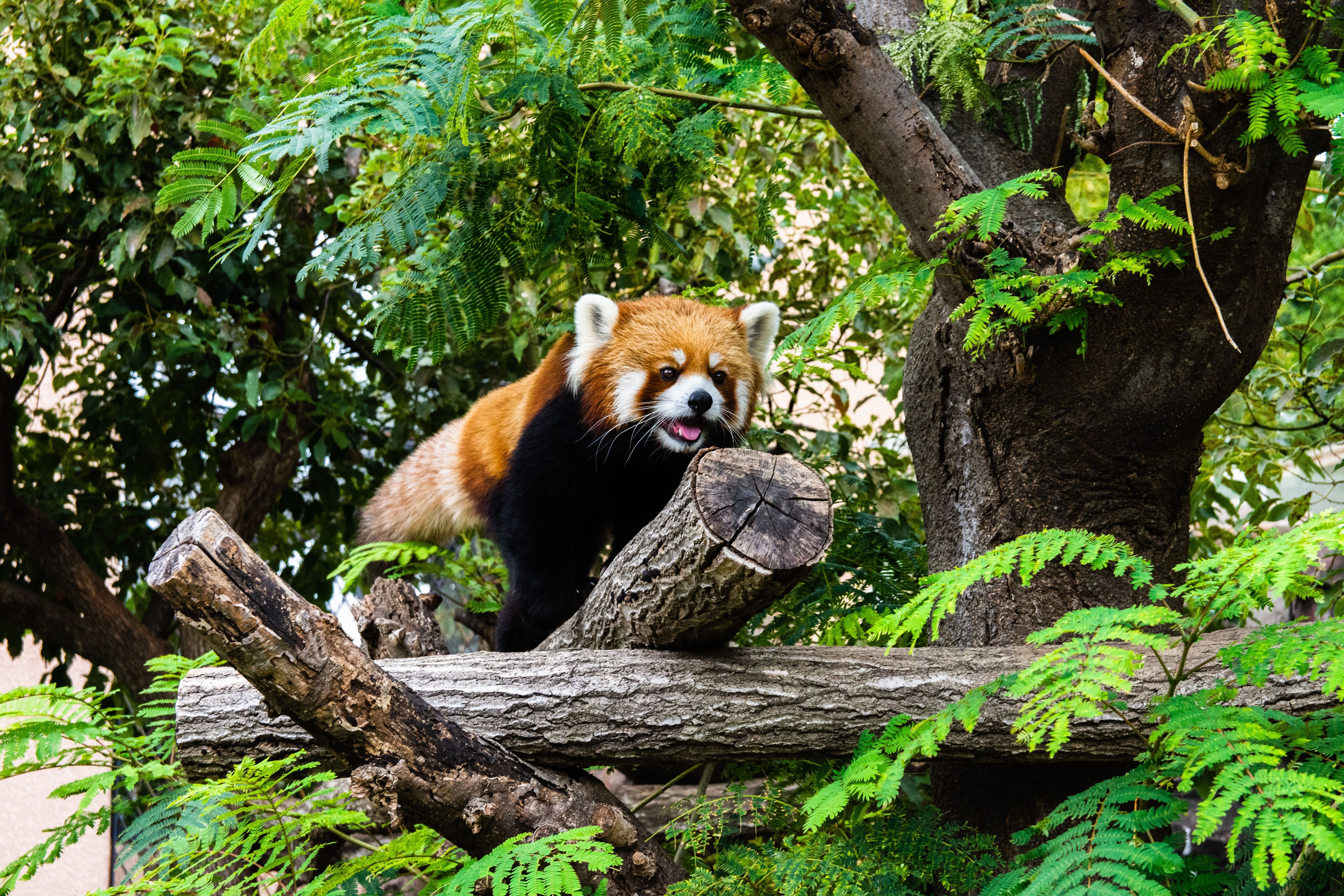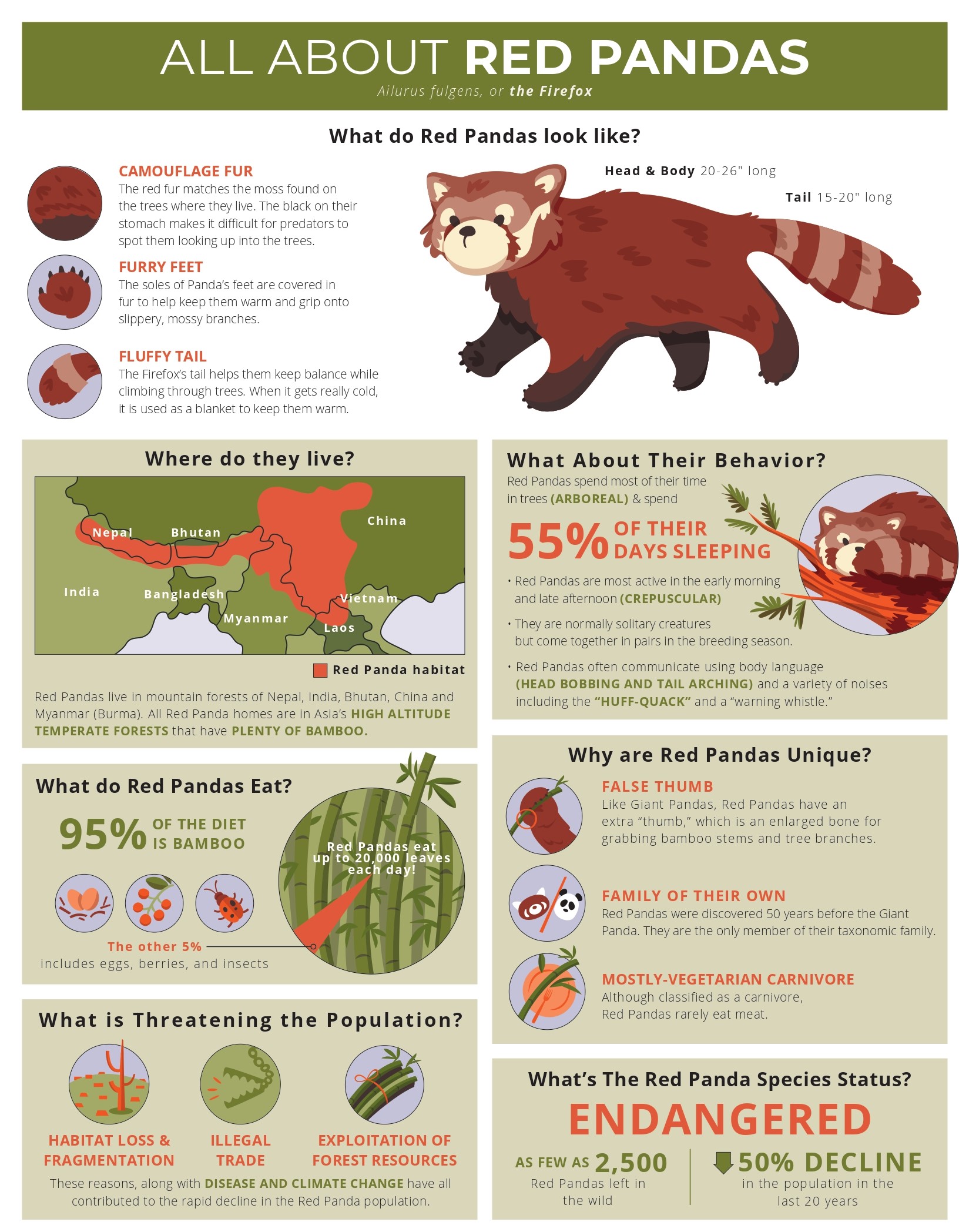
Also called a small panda, as opposed to the giant panda, a bright panda, in reference to its scientific name Ailurus fulgens (which comes from the Greek Ailuros which means a cat, and from the Latin fulgens which means bright), or a firefox, which is the translation of the Chinese term, the red panda was initially classified in the Procyonidae family, because of its morphological resemblance with raccoons. Then he passed into the Ursidae family, like his distant cousin the giant panda. But scientific studies have revealed its particularity and a family was then dedicated to it, that of the Ailuridae, lined with the Mustelidae (weasels), Procyonidae (raccoons) and Mephtidae (skunks) in the super-family of the Musteloidea, which belongs to the order of the Carnivores.
There are two subspecies of red pandas: the small panda of India (A. fulgens fulgens) and the small panda of Styan (A. fulgens styani). The second, slightly larger and darker than the first, is found only in northern Myanmar and in some provinces of China (from the Hengduan Mountains to Sichuan, as well as east of the Nujiang River of Yunnan Province). The small panda from India can be seen in Nepal, Bhutan, north-eastern India (West-Bengal, Sikkim, Arunachal, Pradesh) and in part of China. It is the national emblem of Sikkim.

The red panda is 50 to 60 cm long, without the tail (which is itself 30 to 50 cm), and less than 30 cm high at the withers. The fur is reddish brown on the back, black on the belly and legs, and has the inside of the ears, cheeks, snout and eyebrows white . Its tail, ringed red and beige, serves as a balance when it climbs. It is a remarkable climber able to come down from a tree head first, thanks to its powerful semi-retractable claws and hind legs, which have the faculty of being able to pivot for nearly 90°. It has the particularity of having hairs up to the ends of the legs and between the pads, which allow it to withstand well the winter climates. Despite its thick fur, the red panda does not weigh very heavy, between 3 and 6 kg. Its most developed senses are sight and smell. Finally, like its cousin the giant panda, the small panda has a sixth finger with the front legs. It is not an opposable thumb as in primates, but a modified wrist bone that acts as a fake thumb and allows pandas to grasp bamboo branches more easily. It lives on average 14 years (8 to 10 years in the wild, up to 18 years in captivity).
Red pandas are solitary and rather nocturnal. The home ranges of males and females overlap, but they rarely see each other. Red pandas save energy and cover only a quarter of their home area per month. They have several ways of marking their territory, including urinating and depositing secretions from their anal glands and pads along the boundaries of their territory. They also have “communal latrines” that line their borders, allowing them to share different information, such as whether or not the females are in oestrus. They also communicate through a variety of sounds (grunts, whistles, etc.) and gestures (nods, bow tails, etc.).
During the breeding season, from January to March, male and female mate. Then each one resumes his activities on his side, the female raising alone her 2 cubs (rarely 3 or 4) after 135 days of gestation on average. The cubs are born between May and July, measuring only 6 cm and weighing just over 100 g.

They already have a small fur but keep their eyes closed for up to 18 days. They will not come out of the den until after 3 months, and will be weaned at 5 months. They will stay with their mother for about a year, in all, while reaching their adult size, and will be sexually mature around 18-20 months.
Red pandas live in the temperate forests of pine, deciduous and other rhododendrons in the foothills of the Himalayas (between 1000 and 4800m above sea level). The temperature of this region is cool but there is little annual variation. They are particularly fond of bamboo underwood, which provide them with most of their food. These underwood, however, only form narrow bands throughout their range, which greatly limits their territory.

The term panda is an anglicization of the word “poonya” which means “bamboo eater”. Indeed, the diet of red pandas consists of 95% bamboo, fact to say the least unusual in carnivores, which apparently comes from an ancient adaptation of the animal, since scientists have found fossils of similar species in Europe and North America dating from the Miocene (25-5 Million years) and Pliocene (5-2 Million years), suggesting that the animal once had a much wider range, corresponding to the amount of bamboo growing on the planet as a result of different climate changes. Fortunately for the species, bamboo continues to thrive in southern Asia. The remaining 5% of its diet are fruits, berries, roots, bark, fungi, lichen, insects and other small animals, which it finds in summer.
The food specialization of the red panda has a big impact on his daily life. Indeed, bamboo is very rich in non digestible fiber by our little Carnivore, which has neither the teeth nor the digestive system adapted. As a result, it extracts only a quarter of the nutrients it needs from bamboo. And bamboo being its only food resource in the winter, the small panda can lose up to 15% of its weight during this period. As a result, it adapted its behaviour to compensate its energy needs. For example, the red panda can spend up to 13 hours a day munching on young bamboo shoots and leaves. It also has a very low metabolism, which it can slow down when temperatures fall. Finally, its thick fur allows it to keep its body warm, especially since it is not very tall, and when it sleeps, it usually snuggle itself, bringing its bushy tail on its nose.

The exact size of the current population of Red Pandas in the wild is unknown, but it is estimated that less than 10,000 individuals remain and that this population is decreasing. The species is classified as Endangered in the IUCN red list (International Union for Conservation of Nature), and in Appendix 1 of the CITES (Convention International on Trade of Endangered Species). Apart from its natural predator, the clouded leopard, this decline in population is mainly due to the reduction of its habitat, for forestry for example, but also to poaching, in the tradition was offered a hat in red panda hair to the future groom to bring him happiness, or to inbreeding, because of the fragmentation of their habitat, the populations of red pandas are isolated from each other. Several countries have established protected areas, such as China, whose giant panda sanctuaries benefit many other species, such as the small panda, but protection measures have yet to be developed. Many Nepalese rely on the habitat of the red panda to survive as they currently have no viable alternative economic options. Associations such as the Red Panda Network are working with local authorities to try to create a new system where conservation of red panda habitat would benefit surrounding communities. In addition, zoos around the world have mobilized to preserve the species by participating in breeding programs, with the aim of obtaining a large captive population and with a great genetic diversity so that one day they can reintroduce them into their natural environment.

